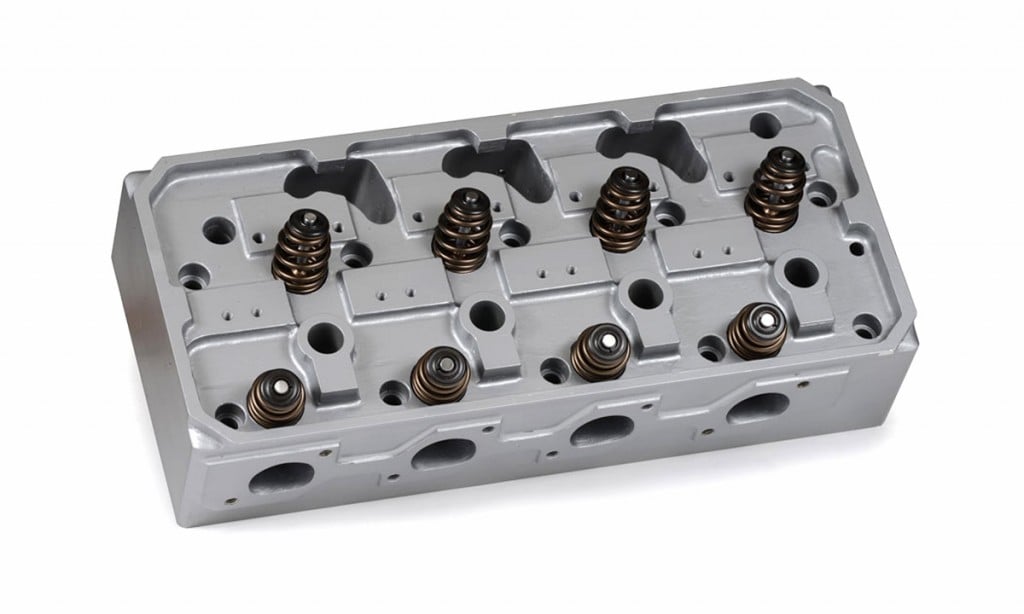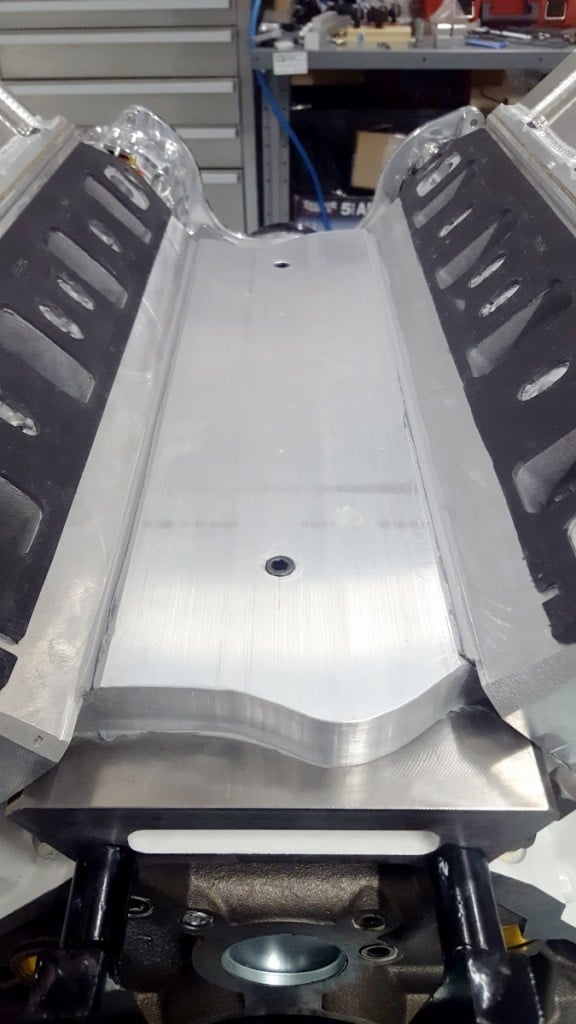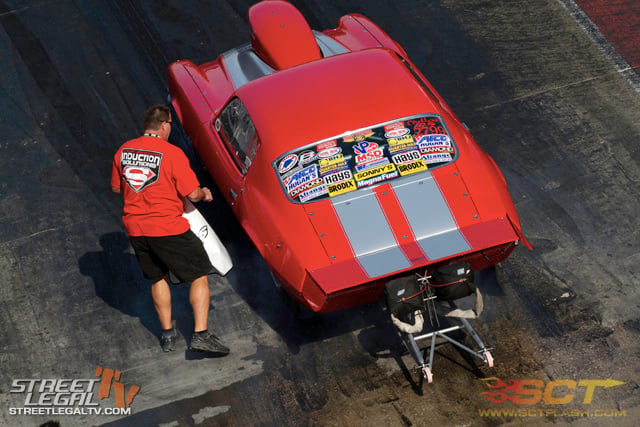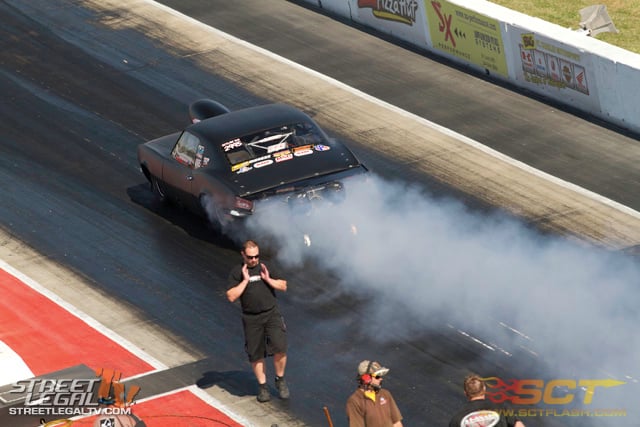Words: Jeff Smith; Photos: Moore Good Ink and Jeff Smith
What would you call a Windsor small-block Ford running a set of hemi heads? A Windshemi, a Hemsor, or maybe a Hemi-Wind? None of those really roll off the tongue, but that’s okay. It doesn’t matter what you call it. What’s more important is that Ford fans now have yet another path to cool horsepower. Give the credit to Hammerhead Performance’s owner Greg Brown and his willingness to try something a little bit different.
The headlines tout some impressive features. These new aluminum hemi heads will bolt directly to any small-block Ford from a 289/302 all the way up to 351W as well as Cleveland engines. A recent test of a prototype set of Hammerhead’s castings bolted on a 427ci small-block stroker produced over 600 hp with a streetable hydraulic roller camshaft and 600 lb-ft of torque. That’s 1.4 hp/ci at a reasonable 6,000 rpm.

Hemi heads are inherently large in order to accommodate the wide spacing of the valve angles. Brown’s heads will feature a tall valve spring installed height to allow plenty of valve lift and will come with beehive style springs intended for a hydraulic roller cam.
Hemi head conversions are nothing new. While Chrysler made the word famous, they were hardly the first. The first automotive use of a hemispherical chamber can trace its lineage to a Fiat-built overhead valve engine raced in 1907, according to Wikipedia. The first hemi for domestic performance was the now-famous Ardun head conversion for the flathead Ford V8 in 1947. The Ardun head was designed by an engineer by the name of Zora Arkus-Duntov who went on to become synonymous with early Corvette development at Chevrolet.
Other versions notwithstanding, it’s easy to see enthusiasm for a conversion like this. In the street rod area, there’s a movement toward alternative engines in response to the market saturation caused by an overabundance of LS, Mod motors, and small-block Chevys. Many traditional rod builders are trying out older engines like nailhead Buicks and even inline sixes. While these older powerplants are cool, their use of rope seals main seals, poor efficiency, and lack of performance make them less than desirable unless you just put them on a shelf.
So imagine the impact of a hammered ’34 Ford coupe with an open engine compartment sporting the wide expanse of a pair of the Hammerhead hemi valve covers jutting out between the frame rails. The visual impact alone would be outstanding but thankfully you could back this up with impressive performance as well.
- Jimmy Robbins improved his qualifying effort in Super Street from tenth to third with a 6.801 @ 203.77 mph pass. Tony Nesbitt also jumped from ninth to fifth.
There’s much more engineering in this effort than just squeezing a hemispherical chamber into an aluminum casting. Brown has been developing this idea for a couple of years. The idea was to create a bolt-on hemi head for the small-block Windsor Ford that would make the conversion as simple as possible. While the head bolts directly in place of the original wedge head, the placement of the valves will require specific pistons in order to position the proper reliefs for valve-to-piston clearance.
Brown says that if the cam is mild enough with reduced lift, you can get by with wedge pistons especially if the ring package is far enough down the piston that small valve reliefs can be milled into the top. Otherwise, he is working with Diamond Pistons (and other will no doubt soon follow) that can offer a custom piston. In Brown’s 427 test engine, he ordered a 25cc dish in his Diamond pistons that combined with the 62cc chamber to create a 10:1 compression ratio.
The big advantage to any hemi is its opposing valve angles that as the valves open, the angle aims the valves toward the center of the cylinder. This is the opposite of a wedge head where the valves often open toward the cylinder wall, which shrouds the valves, reducing airflow. The net result for a hemi is better cylinder filling and generally better power.
One of the first questions that often accompany a radical idea like this is “how many specialty parts will be required in order to bolt this head on a typical small-block?”
A hemi-specific intake manifold would radically increase the cost of this conversion so Brown designed his heads to accommodate existing small-block Ford Windsor intake manifolds. So for a short 8.2-inch deck height 289/302 engine, the hemi heads would use a 289/302 intake. For taller 351W engines with a 9.5-inch deck, these engines would use the 351W style intake.

The tall heads also requires a spacer to cover the lifter valley that will be supplied with each set of heads.
Because of the hemi head’s tall intake face area, Brown had to create a large lifter valley cover that fills in the area underneath the manifold. While a physical necessity, it also insulates the bottom of the intake manifold from hot oil much like the popular air gap style carbureted intakes.
Moving to the actual head, one of the biggest challenges Brown faced was adapting the valvetrain and especially the exhaust valves as they are positioned on the outboard side of the combustion chamber. For valve operation, Brown chose to have Jesel design a 1.7:1 rocker shaft system for the heads that obviously includes an inherently long exhaust rocker. The lobe orientation for the camshaft remains the same so any SBF cam can be used. The heads are completed with 1.50-inch diameter beehive springs intended for hydraulic roller applications. Brown says that the pushrod locations are such that there should be no need for grinding the block in order to create clearance.
Valve sizes for the head are monstrous at 2.200- and 1.650-inch with intake flow numbers of over 360 cfm at 0.600-inch lift. We also noted an interesting wedge or flow director in the chamber between the intake and exhaust ports, along the line of similar peaks found in wedge style chambers.
This bolt-on approach also means that this head will work with typical engine-specific composition or MLS-style head gaskets, again aimed at reducing the cost of the conversion. We’ve listed some Fel-Pro gasket numbers for reference in the head tech chart. The only hemi-specific gasket is for the valve cover, supplied by Flatout gaskets.
On the exhaust side, these hemi heads will obviously require a custom header but the flange is a duplicate of the Ford/Yates C3 flange so there are gaskets available. Flanges that can be used to make a set of headers are available from several sources such as Hedman, Kook’s headers, and SPD, a Ford exhaust flange specialty company.
Brown did mention one additional detail that concerns the distributor. With the taller heads, the distributor body interferes with the water cross-over on some Windsor manifolds so a spacer is needed increase the height of the distributor. Price Motorsport Engineering (PME) makes just such an extension for small-block Ford distributors. The spacer costs roughly $120 and we’ve listed PME’s contact information in the Source Guide.
The best way to evaluate these heads is to bolt ‘em on an engine and run ‘em on the dyno. So Brown built a World Products 427 stroker Windsor shortblock. The rotating assembly consisted of a Callies crank and rods and a set of custom Diamond pistons at 10:1 compression while the camshaft he selected is a Comp hydraulic roller with 246 at 0.050 degrees of duration camshaft with just 0.600-inch lift .On top he added an Edelbrock Victor, Jr. intake and a very streetable Quick Fuel 750 cfm carburetor. With an MSD ignition, the power numbers in the chart reveal over 600 hp and 600 lb-ft of torque with a 1,500 rpm power band. That’s enough to put a 3,600-pound car into the mid 10’s at over 125 mph.
There’s quite a bit of history and more than a little mystique swirling around about hemispherical combustion chambers. Greg Brown has just tapped into that for the small-block Ford engine market and it looks like an idea whose time has come. Brown says that a complete Hammerhead kit with a hydraulic roller cam will start at $5,995 and go up from there. But it shouldn’t be long until we’ll see small-block Ford hemis taking to the streets.
Dyno Test Results
The following dyno numbers were recorded on Charlie Pepper’s dyno using a 427ci stroker small-block Ford. The components include a World Products iron block, Callies Compstar 4.00-inch crank and 6.20-inch rods, custom Diamond forged pistons, Comp 242/248 degrees at 0.050 duration cam with 0.576/0.600-inch valve lift and a lobe separation angle of 110 degrees. On the intake side Brown used an Edelbrock Victor, Jr. carbureted manifold and a Quick Fuel 750cfm 4150 carburetor, an MSD distributor and MSD hemi style plug wires. Innovators West supplied the harmonic balancer and it was tested with a Billet Specialties serpentine accessory drive.
Of interest is Brown’s report that the engine only required 28 degrees of total ignition timing to make best power. A lower total ignition timing number indicates a very efficient combustion space. A typical small-block Ford wedge engine total timing number would be closer to 36 degrees.
| RPM | TQ | HP |
| 4,400 | 601 | 512 |
| 4,500 | 601 | 516 |
| 4,600 | 600 | 523 |
| 4,700 | 594 | 531 |
| 4,800 | 589 | 538 |
| 4,900 | 586 | 547 |
| 5,000 | 584 | 556 |
| 5,100 | 582 | 565 |
| 5,200 | 580 | 575 |
| 5,300 | 578 | 583 |
| 5,400 | 573 | 589 |
| 5,500 | 568 | 594 |
| 5,600 | 560 | 597 |
| 5,700 | 552 | 600 |
| 5,800 | 545 | 602 |
| 5,900 | 538 | 604 |
| 6,000 | 528 | 604 |
| 6,100 | 517 | 601 |
| 6,200 | 506 | 596 |
| 6,300 | 493 | 592 |
| 6,400 | 479 | 584 |
| Peak | 601 | 604 |
| Average | 559.7 | 571.8 |
Ford Hemi Head Specs
| Description | Spec |
| Intake bolt pattern | Any Windsor style Intake |
| Exhaust bolt pattern | Raised, Yates C3 |
| Intake valve, stainless steel | 2.20-inch |
| Exhaust valve, stainless steel | 1.650-inch |
| Valve spring diameter | 1.50-inch |
| Spring installed height | Up to 1.950-inch |
| Combustion chamber | 62cc |
| Valvetrain | Jesel Rocker Shaft System |
| Rocker ratio | 1.7:1 |
| Head gasket | Fel-Pro 1011-1 (for 302-351W) |
| Intake gasket | Fel-Pro 1262R |
| Exhaust gasket | Fel-Pro 1433 |
| Head bolt lengths | 4.250 and 4.750 (under head lengths) |
| Head stud lengths | 5.250 and 5.750 |
| Spark plug | ¾-inch reach, gasket style, i.e. Autolite 3924 |
| Valve cover | Cast or sheet aluminum supplied with heads |
Source: Hammerhead Performance Engines, Hammerheadperformanceengines.com; Jesel, jesel.com; Price Motorsport Engineering, pricemotorsport.com; Specialty Products Design (SPD), Spdexhaust.com


























